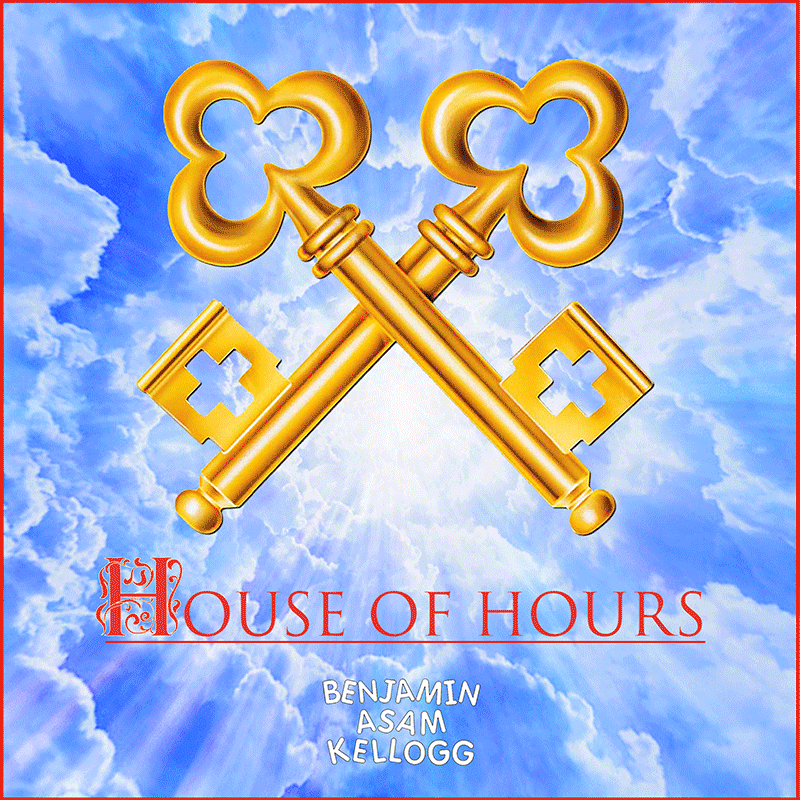Benjamin Asam Kellogg: House of Hours
February 15 — March 21, 2020 Opening Reception: Saturday, February 15 | 5-8pm
Press: Cultured | Tzvetnik

Installation view






Tree of Eternal Afterlife, 2020.
Venetian plaster, gold leaf and acrylic paint on canvas
Venetian plaster, gold leaf and acrylic paint on canvas
 Scrying Altar Bearing the Lesser Lights, 2020.
Scrying Altar Bearing the Lesser Lights, 2020.Stone bowl, candles, water, ink on wood pedestal
 Philosophical Key, 2020.
Philosophical Key, 2020.Gold leaf, brass



 Pavilion of Light, 2020.
Pavilion of Light, 2020.Venetian plaster, gold leaf, wood on paving brick

Pavilion of Light, 2020. Detail
Venetian plaster, gold leaf, acrylic paint, wood on paving brick
Venetian plaster, gold leaf, acrylic paint, wood on paving brick
 Pavilion of Shadow, 2020. Detail
Pavilion of Shadow, 2020. DetailVenetian plaster, gold leaf, wood on paving brick
 Temple of Hours Cloister Vista Triptych (Day), 2020.
Temple of Hours Cloister Vista Triptych (Day), 2020.Woven tapestry

Temple of Hours Cloister Vista Triptych (Day), 2020. Detail
Woven tapestry

Temple of Hours Cloister Vista Triptych (Day), 2020. Detail
Woven tapestry

Temple of Hours Cloister Vista Triptych (Night), 2020.
Woven tapestry
![]()
![]()
Woven tapestry

Temple of Hours Cloister Vista Triptych (Night), 2020. Detail
Woven tapestry
Woven tapestry

Temple of Hours Cloister Vista Triptych (Night), 2020. Detail
Woven tapestry
Woven tapestry
Murmurs is pleased to present Benjamin Asam Kellogg’s first solo exhibition in Los Angeles, House of Hours, a study of the symbolic dualities of time and ritual using elements of sacred architectural temples and graphic motifs from medieval illuminated manuscripts. Reckoning with the natural cycles that govern daily human life is a universal tradition older even than the concept of time itself. All past ancient civilizations created their own emblems to comprehend day changing to night, fertility patterns, and the rhythms of life and death. Through deciphering cryptic and fractured visual artifacts these ideas that have laid dormant for eons are reborn as timeless parables. To distill this complex web of ancient information and view it with our present-day consciousness is to study symbolism — these are the powerful gems garnered from ancient knowledge: universal, ineffable ideas boiled down into a singular visual cue. They have a foundational significance on a global level. The eternal age of these symbols are a testament to their undying power.
House of Hours is a glimpse into a microcosm of pure symbolic exchange, where even the architecture is built to veil a deeper reality. Mimicking ancient city planning wherein temples were built to be in sync with the spirit of the land, the physical contours of the installation are aligned into a bisected path that shows day and night diverging in a spatial rather than temporal modality. A solar burst, the standard symbol of the sun which rules all creation hovers over the right-hand path— the path of day. Invoking the moralistic bisection of the body originating in Vedic teachings and subsequently adopted by occultists, the right hand path (Dexter) symbolizes balance, righteousness, and God while the left-hand path (Sinister) symbolizes breaking taboo, questioning authority, and general anarchy. In the installation, night occupies the left path and is marked by a lunar crescent. The moon is believed to rule emotions and the internal self, perhaps because the disappearance of the primary energy source has dramatic effects on the subconscious mind— the night sky opens like a window allowing insight to the universal standard of “darkness.”
Symbols are the only entity that can move freely between our subconscious and conscious minds, manifesting in our dreams and bringing us closer to an ignored truth in our waking life. The optical illusion on the floor of the pathway is intended to disorient and confuse spatial awareness, in the hopes that a rare break in spatial mastery will promote introspection and provoke a bending of consciousness. The more time the viewer spends inside the installation decoding the works, the more hidden layers are revealed: the phoenix is the occult symbol of regeneration, keys are a metaphor for secret knowledge encoded in the stone work of cathedral architecture, gold symbolizes the light of the sun because it was considered by ancient alchemists to be the highest form of matter. The fulcrum of the entire installation is the altar where the stone scrying bowl rests. All energy is directed towards the water which is meant to be a surface for the ancient art of scrying, or gazing into the water in hope of seeing significant messages. In this gesture the show comes full circle, suggesting that each cycle begins and ends with your own willingness to be a conduit to the eternal, universal symbolic noise that surrounds us.
Benjamin Asam Kellogg (b. Long Island, NY, 1991) attended The Cooper Union. His work draws from the architectural and symbolic history of an elite and secretive class, borrowing from the crests, engravings, and cryptic ornamentation of facades. Kellogg applies the logic and vernacular of the semiotician, following tenuous but poetic connections between the entertain-ment industry, religious or occult institutions, and political organizations. Whether or not a particular connection can be proven is secondary to the kernel of truth that lies in the impulse to seek it. At the heart of this practice is a longing, or a prayer, for an essential truth that may never be told. Kellogg is currently based in New York and has shown there in addition to Germany, London, France, Japan, and Italy. This is his first solo exhibition in Los Angeles.
DOWNLOAD PRESS RELEASE



